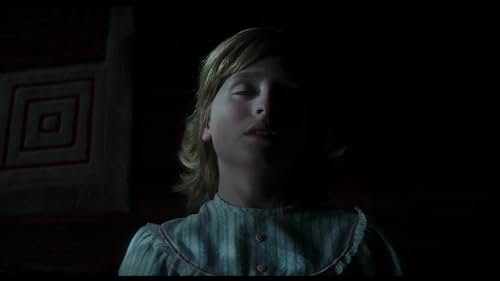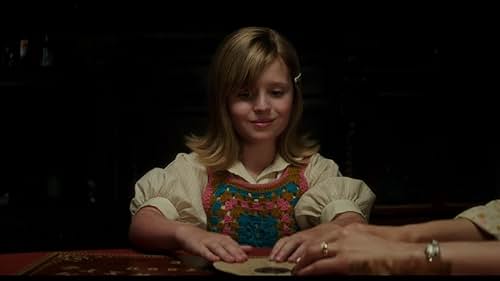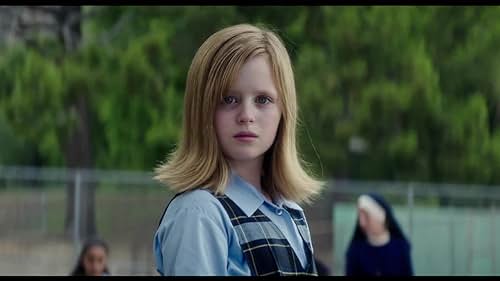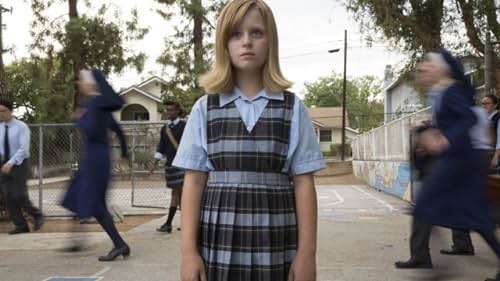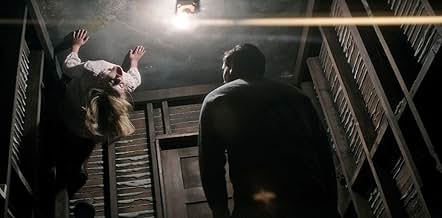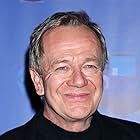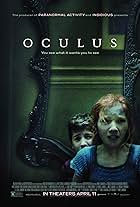In 1967 Los Angeles, a widowed mother's daughter tries to communicate with her late father through a Ouija board, but unleashes a demon instead.In 1967 Los Angeles, a widowed mother's daughter tries to communicate with her late father through a Ouija board, but unleashes a demon instead.In 1967 Los Angeles, a widowed mother's daughter tries to communicate with her late father through a Ouija board, but unleashes a demon instead.
- Awards
- 2 wins & 7 nominations
Blumhouse Horror Films, Ranked by IMDb Rating
Blumhouse Horror Films, Ranked by IMDb Rating
Storyline
Did you know
- TriviaThe film was shot digitally, but director and editor Mike Flanagan, in order to add a retro feel to the film, added elements in post-production to give the appearance of a movie shot on film. Those include the 'cigarette burns', marks that appear every 20 minutes or so in the upper right corner of the frame, which were used to signal a change of reels for film projected.
- GoofsIn order to make the film appear more authentic for the time in which it is set (1967), cue marks, or "reel change" marks, are inserted at approximately every 20 minutes. However, the marks are oval when they should actually be circular, since this is a film presented in a 1.85:1 aspect ratio and not in a 2.39:1 aspect ratio. The only time the marks should be oval is if a film is projected with an anamorphic lens. On an anamorphic film print, the cue marks are circular, but the anamorphic lens makes the circle look like an oval when projected on a screen.
- Quotes
Doris Zander: Wanna hear something cool?
Mikey: Sure.
Doris Zander: Do you know what it feels like to be strangled to death? First, you feel the pressure in your throat. Your eyes water, and you start to taste something very, very sour in your mouth. Then it's like someone lights a match right in the middle of your chest, and that fire grows. It fills your lungs, and your throat, and all the way behind your eyes. And finally, that fire turns to ice; like pins and needles of ice are sticking into your fingers, your toes, your arms. You see stars, then darkness. And the last thing you feel... is cold.
[Mikey looks confused and horrified]
Doris Zander: [smiles] Goodnight, Romeo.
- Crazy creditsThere is a post-credits scene with Lin Shaye.
- SoundtracksYou Gotta Move Me
Written by Dennis Michael Lacey
Performed by Mike Lacey
Courtesy of Crucial Music Corporation
Perhaps it should not come as a surprise that "O of E" turned out so well. With the steady guidance of director Mike Flanagan (Hush, Oculus, Haunting of Hill House), one of the most consistent creators of scary stories in the business, we should expect high quality work. Once again, he delivers.
The story revolves around a recently widowed mother and her two daughters. At risk of losing their old, creepy and possibly haunted (definitely haunted) house, the mother resorts to work as a fake medium to make money, calling on her daughters to contribute to the ruse. Things get more exciting when the mother brings home a Ouija board, not knowing that sinister spirits would soon possess her younger daughter.
Then, as we witness the little girl's behavior grow increasingly strange, our goosebumps grow increasingly prevalent (because creepy little girls are a reliably freaky scary movie trope). The older sister soon suspects something, the little girl crawls on walls, and a priest shows up to help. That stuff is predictable and somewhat unoriginal. But this movie still works because of its splendid acting - the little girl, Doris (Lulu Wilson), is particularly impressive - and deft direction.
Mike Flanagan clearly knows how to run the show. He makes sure that "O of E" becomes a far cry from other horror movies of this ilk, which possess so little inventiveness in their direction.
With this film, we are treated to elegant camera movement, unnerving closeups, and evocative framing and angle choices that all appear purposeful and thought through. Instead of calling attention to an evil presence on screen with a hard cut, we simply see a shadowy figure crouching on the edge of the frame.
Flanagan also chooses to include limited jump scares and, mercifully, no fake jump scares. Fake jump scares are what I call those moments of building tension when the sound goes silent, then suddenly there's a blast of jarring noise that makes us jump out of our seats as the camera reveals a harmless friend character. It's a cheap manipulation, a dirty trick. We deserve better, and Flanagan gives us better.
Rather than turning to a loud and bombastic score to sell scares, Flanagan relies on the editing and our natural inclinations as viewers to feel scared. He trusts that when something scary that unexpectedly appears in front of us on screen, it will deliver chills.
"O of E" delivers a slow-building eerie viewing experience. There are no excessive bursts of violence. Nothing is over-the-top. It's a small-scale movie, but one that is nonetheless effective. I recommend it to any fans of possession movies, especially if you prefer ones devoid of gore.
- Jared_Andrews
- Oct 27, 2019
- Permalink
- How long is Ouija: Origin of Evil?Powered by Alexa
Details
- Release date
- Country of origin
- Official sites
- Languages
- Also known as
- Ouija: el origen del mal
- Filming locations
- Clark Residences - 306 Loma Drive, Los Angeles, California, USA(the girl's school)
- Production companies
- See more company credits at IMDbPro
Box office
- Budget
- $9,000,000 (estimated)
- Gross US & Canada
- $35,144,505
- Opening weekend US & Canada
- $14,065,500
- Oct 23, 2016
- Gross worldwide
- $81,705,746
- Runtime1 hour 39 minutes
- Color
- Sound mix
- Aspect ratio
- 1.85 : 1
Contribute to this page


